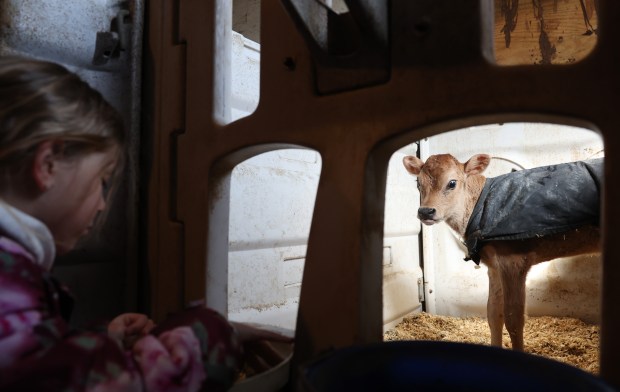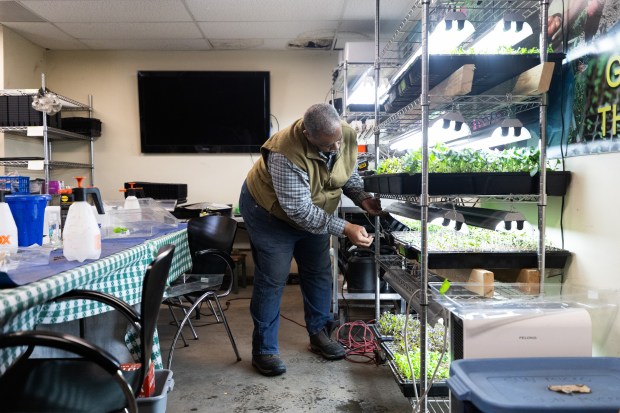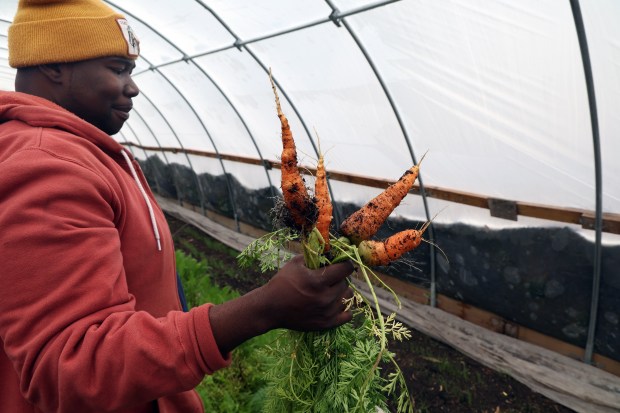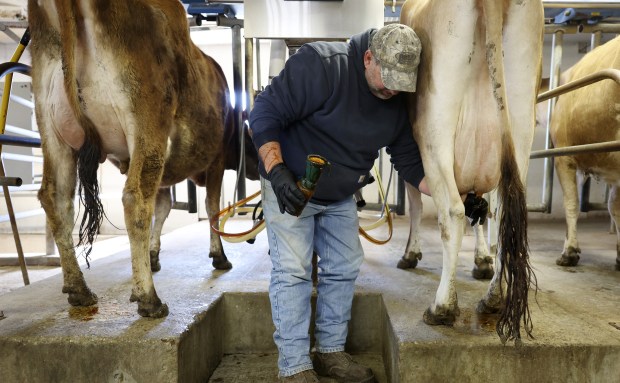A dairy farmer in northern Illinois was dumping milk down the drain two hours west of Chicago. Three and a half hours away in central Illinois, another farmer was running out of cold storage space for his poultry. Meanwhile, over 3 million Illinoisans live in food deserts, and food pantries across Chicago have struggled to meet unprecedented demand.
After months of delay, these farmers hope a multimillion-dollar state program to connect underrepresented farmers with communities in need can help them get their products in more grocery stores, restaurants and family kitchens soon.
The Illinois Equitable Access Towards Sustainable Systems (IL-EATS) program is part of a larger push to improve intrastate food supply chains, which stimulate local economies and make fresh, healthy food more accessible. Even though farms make up 75% of Illinois’ land area, 95% of the food consumed in Illinois is purchased outside the state, according to the Illinois Local and Organic Food Farm Task Force.
Farmers across the state spent several months ramping up production in anticipation of the program’s target January start date. First-generation dairy farmer Doug Graybill got more cows and extra feed. Ed Dubrick, a veteran and first-generation farmer, spent $25,000 to double his poultry production and increase storage capacity. Then, they waited through the winter as their inventory increased, and nothing happened.
Budding urban farmers in Chicago’s South Side, which has a high concentration of food deserts, have also been itching to use the program to get their produce on local markets.
“The whole point of this program was to uplift underserved farmers, people of color, veterans, beginning farmers, etc.,” Dubrick said. “A lot of those people already have a certain level of distrust in government institutions that have not always treated them fairly over the years. And now, we have this program that is continuing to reinforce those thoughts.”
According to the state Departments of Agriculture and Human Services, unexpectedly high demand and logistical hurdles delayed the rollout. The Pritzker administration finally announced the launch of the program in early March and farmers are just starting to cash in.
As IL-EATS gets underway, farmers and advocacy groups applauded the announcement of the Local Food Infrastructure Grant awards on Wednesday. This $1.8 million state-funded grant was designed to complement IL-EATS by giving farmers an avenue to purchase equipment they need to get their food to local markets.
It similarly received far more interest than anticipated, according to the Illinois Stewardship Alliance, a nonprofit tasked with administering the grant. Nearly 250 applicants submitted proposals, totaling over $23.5 million in funding requests.
“The tremendous demand shows more (food infrastructure) funding is needed,” said Josh Snedden, the alliance’s grant coordinator, during the Wednesday announcement.
Meanwhile, it remains to be seen how farmers will recoup losses incurred by the delayed start of IL-EATS.
Learning curve, high demand
In fall 2022, Illinois received $28.8 million in federal funds to get produce, dairy and meat from beginning, women, veteran, LGBTQ, Black and brown farmers to nearby food banks, schools and nonprofits.
The money will be doled out to community-based organizations — called lead agencies — to oversee the procurement and distribution of the food. The state partnered with the University of Illinois Extension to connect qualifying farmers with lead agencies in their area.
“In essence, we’ll be taking away some of the stigma of having to go to a food pantry. We’re going to be providing these communities the exact same quality of products that we take to Boka restaurants or Frontera Grill,” said Marty Travis, a sixth-generation farmer. His food hub, Down at the Farms, which currently connects over 60 farmers in central Illinois with Chicago-area restaurants, is partnered with a lead agency.
Farmers were amazed last summer when they learned the state planned to essentially pay retail prices for wholesale products, and the program spread quickly by word-of-mouth.
“With the opportunity this grant gives us to really grow — and they’re paying a really fair price — it’s really too good not to do as much as we can,” said Graybill, who is selling yogurt through IL-EATS.

He and farmers across the state got to work quickly. After all, it takes four to six months for laying hens to mature, six to eight months for pigs to reach butchering size and several months for produce to sprout.
Then, when the lead agencies weren’t announced this winter, farmers were left with excess.
“We fed extra calves and a bunch of milk did get dumped down a drain,” said Graybill. “You can’t just stop milking a cow.”
He refrained from taking on new contracts in anticipation of the high demand IL-EATS would put on his farm, so there was nowhere to redirect the milk when the money didn’t come through.
“I just wonder if (the state agencies) don’t understand. It’s not just like a great big dairy farm where you can absorb 10,000 pounds (of milk) here and then 10,000 pounds over there,” continued Graybill, who only produces yogurt, buttermilk and sour cream. “We’re just a little tiny farm. Five hundred pounds of milk is a big deal.”
The state agriculture and human services departments said the delay was primarily because of a learning curve and high demand. About half of the lead agencies had never applied for a state grant and the total funding requested for the first six months of the program exceeded the $28.8 million allotted for its 18-month lifetime. The departments spent the last several months working with all 20 lead agencies to revise their budgets and equitably distribute the funds.
It may also be several weeks until the state can provide funding to purchase food, said the departments. Until then, lead agencies’ only option is to submit reimbursement forms to the state after the fact.

“We’re being told to ask these farmers to bankroll the program with an interest-free loan. We don’t feel like that’s appropriate,” said Ryan Slabaugh, founder and director of Think Regeneration, the lead agency working with Travis’ Down at the Farms.
Ultimately, Down at the Farms began distributing products through IL-EATS last week even though Travis is unsure how soon he will be able to pay farmers for these goods. He and Slabaugh would like to compensate them weekly but were told reimbursements would be processed in 30- to 60-day intervals.
“We are exploring creative options with banks and agencies in Illinois to help secure the funding and de-risk this program for the farmers who are participating,” said Slabaugh. “It’s a puzzle, but we’re figuring it out.”
Delays lead to distress
Travis fielded distressed calls from farmers throughout the winter.
“I have been this crisis manager, trying to be this calming voice,” he said in early March. “I’m also trying to move as much as I can through (Down at the Farm’s) regular channels, but it’s not stopping the hemorrhage.”
Many farmers were depending on the program to rebound from the pandemic.
“We’ve really put a lot of eggs — literally — into the IL-EATS basket,” said Travis.
He recalled a pork farmer whose restaurant sales took a huge hit in recent years and was depending on the program to improve cash flow. When the funding didn’t come through in January, he had no choice but to sell his pigs. Today, Travis is working with the farmer to sell the remaining processed pork he has on hand.

Meanwhile, Dubrick, who started farming in 2020 after serving in the Illinois National Guard, worries about paying off the tens of thousands of dollars in loans he took out to buy more chickens and upgrade his freezer lockers to increase capacity for IL-EATS.
“Those loans are still gathering interest. I’m just thankful I have an off-farm day job,” said Dubrick, who also works as a policy organizer at Illinois Stewardship Alliance. “My day job is subsidizing my farming habit right now. It just wouldn’t be possible otherwise.”
The extra cold storage he invested in is to the brim with the poultry he thought he would start selling to lead agencies such as Travis’ months ago.
“Here in another week, I’m taking another batch of chickens to the locker and hopefully I have enough sales to hold all those, otherwise I’m gonna end up having to rent cold storage. So it’s going to add another expense to this program,” said Dubrick in early March.
He finally got to relieve some of the freezer space when he made his first IL-EATS delivery on Thursday.
While he is grateful his frozen poultry has a relatively long shelf life, Dubrick would like to see the state compensate farmers for the perishable goods they had to throw away.
Urban farms to benefit
On the South Side, sandwiched between the I-90 Expressway and Norfolk Southern’s rail yard, farmers at Eden Place Farms have been eagerly awaiting IL-EATS too.
These urban farmers are poised to be an answer to Chicago’s food deserts, said lifelong South Side resident Michael Howard.
He started Eden Place Farms on what was once an illegal dump site in response to a decadeslong food desert in the Fuller Park neighborhood.
“On check day, as we call it, you’ll see a lot of people walking with their carts from Fuller Park to Back of the Yards to the grocery store,” said Howard. “And then, they have to haul all those groceries back in the cart.”

Today, Eden Place Farms grows fresh produce on-property and helps residents set up backyard gardens to ensure fresh vegetables are more easily accessible. Many of these beginning farmers are hoping to sell their produce locally, but it has been difficult for them to compete with larger farming operations for retail contracts.
“IL-EATS will allow all urban farmers, including Eden Place Farms, the opportunity to have a source that we can depend on — for at least the first season — to sell our produce to, which will increase our capacity to do even more sales and more growing,” said Howard.
Three miles up the road at Urban Growers Collective, the social impact of urban farming is encapsulated in Malcolm Evans, 31.
He was first introduced to agriculture at 9 years old when the founder of Urban Growers Collective, Erika Allen, planted a community garden on an old basketball court across the street from his home in Cabrini-Green, a former public housing complex on the Near North Side and food desert.
“Coming from where I’m from, you don’t get a lot of choices in life,” said Evans, for whom the garden became a refuge from violence and racism. He began visiting it every day after school and tending to the crops.

“I just fell in love with (farming). It was just so dope, and I took it to the next level,” he continued. “Now, it’s become a full-time, driven, passionate career that I’ve created for myself and I learned everything hands-on.”
Today, as the director of farming at Urban Growers Collective, which has 11 acres of farmland concentrated on the South Side, he aspires to mitigate urban food deserts and cultivate more farmers of color. He sees IL-EATS as an avenue to do both.
“Now, I’m super excited (IL-EATS) is starting. Hopefully this works out and we can be able to get food into more neighborhoods,” Evans said.
“This is not just a giveaway, but it’s really going to help build and strengthen our foodshed and our emergency food system,” added Allen.
Improving infrastructure
The $1.8 million Local Food Infrastructure Grant awards announced at the statehouse Wednesday are a critical complement to IL-EATS, according to farmers and advocacy groups.
“Farmers needed infrastructure investments for a long time, but the opportunity to leverage federal dollars through IL-EATS provided the momentum and political will to get it funded,” said Liz Stelk, executive director of the Illinois Stewardship Alliance, which lobbied for and was tapped to administer the state-funded grant.
Funding requests far exceeded the available pot, so the grant was ultimately only able to assist 8% of applicants. Travis’ Down at the Farms, Howard’s Eden Place and Allen’s Urban Growers Collective were three of the lucky few.

Down at the Farms plans to purchase additional delivery vehicles, expand storage space and implement a technology to scan and trace products as they travel from central Illinois across the state. Meanwhile, on the South Side, Eden Place Farms and Urban Growers Collective will build food processing centers where urban farmers can store, professionally wash and pack their produce for market.
“The infrastructure investment allows us to participate in (IL-EATS) in a more robust way,” said Allen. “They really go hand-in-hand.”
During Wednesday’s award announcement, the alliance, farmers and lawmakers on both sides of the aisle encouraged the state legislature to harness the high demand for the food infrastructure grant and IL-EATS. All speakers expressed support for a Senate bill that would establish an ongoing food infrastructure grant program with at least $2 million in funding each year.
“We’re extremely grateful and we’re extremely frustrated,” Travis said in early March, shortly after learning he had received the food infrastructure grant and while still waiting for IL-EATS funding. “We have this burning desire in us to support the farm community and to support communities that are really struggling to have great food.”
Karina Atkins is a freelancer.



